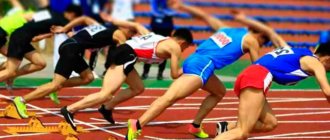The history of sprinting
The struggle for survival dictated to our distant ancestors the need to be fast. To provide themselves with food, they had to run faster than their prey. And already at the first Olympic Games, held in 776 BC, athletes competed in running a distance of 1 stage or 192.28 m.
The familiar word “stadium” arose from the ancient unit of measurement, and the distance itself gradually decreased to 100 m. Nowadays, it is this that attracts the largest number of participants and spectators. Sprinting is power, speed, excitement, dynamics and instantaneous resolution. That is why he has so many fans all over the world.
Rank for men and women
Special standards have been established for races at different distances. Each category corresponds to individual indicators for men and women.
Approved adult categories for women are presented in the table:
| Distance, m | MSMK | MS | KMS | I | II | III |
| 50 | — | — | — | 6,9 | 7,3 | 7,7 |
| 60 | 7,3 | 7,5 | 7,84 | 8,64 | 9,14 | 9,64 |
| 100 | 11,34 | 11,84 | 12,54 | 13,24 | 14,04 | 15,04 |
| 200 | 22,94 | 24,14 | 25,54 | 27,04 | 28,74 | 31,24 |
| 300 | 40,0 | 42,0 | 45,0 | 49,0 | 53,0 | 57,0 |
| 400 | 51,2 | 54,05 | 57,15 | 61,15 | 65,15 | 70,15 |
The category is assigned to athletes who have shown appropriate results in official competitions.
The current adult male standards are as follows:
| Distance, m | MSMK | MS | KMS | I | II | III |
| 50 | — | — | — | 6,1 | 6,3 | 6,6 |
| 60 | 6,7 | 6,84 | 7,04 | 7,34 | 7,64 | 8,04 |
| 100 | 10,34 | 10,64 | 10,94 | 11,44 | 12,04 | 12,94 |
| 200 | 20,75 | 21,34 | 22,24 | 23,24 | 24,44 | 25,84 |
| 300 | — | — | 34,74 | 37,24 | 40,24 | 43,24 |
| 400 | 46,0 | 47,35 | 49,65 | 52,15 | 56,15 | 60,15 |
The results are recorded manually or automatically. Standards met at unofficial competitions cannot serve as the basis for assigning a rank to an athlete.
Technique and phases of sprinting
Short-distance running is conventionally divided into 4 phases: start, starting acceleration, distance running and finish.
Start
The start is one of the most important elements of the sprint. As the runners themselves say, if you “oversleep” the start, then you may not run further, unless, of course, you are Usain Bolt.
Photo: athleticsweekly.com
According to the rules of athletics, all sprint disciplines must be started from a low start. Standing at a low start, the runner goes down on one knee and rests it on the track, while his hands should not go beyond the starting line. He rests his feet on the starting blocks - these are special foot rests necessary for an active jerk forward at the signal from the starting pistol.
At the command “attention”, without taking his hands off the track and feet from the blocks, the athlete raises his pelvis and moves his shoulders forward. When the starting pistol fires or the command “march” is heard, the athlete lifts his hands off the floor, actively pushes himself out of the blocks and begins the starting acceleration.
marathon and half marathon training plans and start training today!
Read more on the topic: Running from a low start: technique, types, mistakes
A low start is also needed so that the athlete takes his first running steps while leaning forward, which allows him to accelerate most efficiently, like an airplane on a runway.
Starting acceleration
The starting acceleration is the first 20-25 meters of the sprint discipline. As the name implies, here the athlete must accelerate and gain his maximum speed to cover the distance.
Active and wide movements of the arms back and forth, as well as wide and powerful movements of the hips, help him in this. This technique is also called the “herringbone” - the feet are placed slightly to the sides from the conditional center line of the track, which allows you to push off most effectively.
And if, during the first steps from the start, the athlete runs out inclined, then by the end of the starting acceleration the body straightens and is about 15 degrees from the vertical axis of the body.
Distance running
After the starting acceleration, during which the athlete reaches about 80% of his speed, he begins running along the distance.
Sprint running is characterized by running “on high feet” or, as it were, on tiptoes. In this case, the foot does not touch the surface of the track with the heel, and the push-off phase occurs faster.
Short-distance running is very different from distance running in that there can be no talk of any kind of economy of movement. Work and movement of arms and legs occur at maximum power for the body.
Interesting material: 8 main differences between a sprinter and a marathon runner
Finish
At the finish line, the speed usually drops by about 3-5%, and it is very important to squeeze the maximum out of yourself in the last meters of the distance. The end of the distance occurs when the athlete touches the imaginary finish line with his chest line. To make this happen faster, you need to do the so-called “chest throw” at the last step - a sharp lean forward, throwing your arms back.
In athletics, there have been cases when an athlete began to tilt his chest a few meters before the finish line and after the finish line fell straight onto the track, unable to stay on his feet. In indoor running, where athletes compete at a distance of 60 meters and at speeds much higher than in a stadium, such incidents are most common.
How to train?
In achieving results in sprint running, the quality of execution of technical elements is of great importance. However, even high precision movements do not provide good results. Therefore, when training sprinters, much attention is paid to physical fitness.
An athlete's maximum speed depends on the length and frequency of the stride. The optimal period for increasing step frequency is between 10 and 14 years of age. However, the frequency can develop after 14 years until reaching adulthood.
A popular exercise for increasing cadence is high-knee running. The idea is to perform 3-5 approaches with a time limit of 20-30 seconds. In a period of 30 seconds, it is necessary to perform the maximum number of movements, but not to violate the technique of the exercise.
Regular stretching after the main workout allows you to develop step length. It is also worth paying attention to the stride length when covering the sprint distance itself.
Errors in execution technique
Errors at the start
- Placing the starting blocks too far from the starting line will prevent you from being able to push forward like a spring.
- When the command “attention” is given, raise the pelvis too high and practically fall off the blocks.
- Place your back foot too far from your front foot and, at the “start” command, do not push off from the blocks, but simply get out of them.
- When taking your first running step, move upward, not forward.
Errors during the starting acceleration and distance running
- When running out from the start, take very small and weak steps.
- To become too enslaved, to create excessive tension and stiffness in movements.
- Do not straighten your knee completely during the push-off phase, run on bent legs.
- Lower your feet when running.
- Do not raise your knees completely and lift your hip up.
- Breathe only through your nose.
Mistakes at the finish line
- It's too early to start leaning forward.
- Do not run past the finish line, but stop almost in front of it or just behind it.
- When finishing, do not increase the frequency of steps, but, on the contrary, stretch it out.
- Take the last step-jump to the finish line.
Photo: altinify.com
Nutrition
Sprinters expend a lot of energy.
To replenish it, foods rich in proteins, carbohydrates and vitamins are required, and a runner needs to receive at least 4000 kcal per day.
Your daily diet should include foods such as:
Sources of vitamin A: carrots, red peppers, liver, butter.
Vitamin B1: nuts, spinach, beans, pork.
Rich in vitamin B6: peas, fish, rice, egg yolk.
Vitamin C: currants, lemons. oranges, rose hips.
Sources of calcium: dairy products, nuts, greens.
- Food should be taken 2-4 hours before the start.
- It is strictly forbidden to run on an empty stomach.
- During long training sessions, athletes lose a lot of fluid, so to prevent dehydration it is recommended to drink about 100 ml of water every half hour.
Athletes should avoid eating the following foods:
Sweet and fatty.
Fast food.
Roast.
Alcohol and energy drinks.
Safety rules for sprinting
- Sprinting forces all the muscles of our body to work to the limit, so it is very important to prepare it for this load: be sure to do a warm-up, stretching, special running exercises and a couple of accelerations with increasing tempo.
- Sprinting is associated with a high probability of injury - it should never be performed on cold (unwarmed) legs.
- When practicing sprint exercises or running, follow the rules of movement in the stadium or arena, because colliding with someone at such high speeds or sharp braking very often leads to injury.
Techniques for increasing speed
To increase your running speed, you need to develop skills that help you achieve your goal. Such techniques are included in training programs and are often performed during training.
A common example is alternating running, which allows you to develop resistance (speed). The exercise is performed on a treadmill, in a stadium or park. Distance - at least 50 meters. You should run very quickly, then start jogging and return to the starting point. Returning to the beginning, without stopping, run again and also come back. It is enough to do 5-10 repetitions.
Variable running (or range) can be performed over medium distances. For example, if you run for a minute at a slow or medium pace, it will speed up by 10-20 seconds. Slow down and run for a few minutes at a moderate pace. Such a run is called torn.
The main methods for increasing running speed are revealed.
These are: the study of individual parts of the technology and their development, as well as the high-speed resistance technique.
Exercises to practice technique
To teach short-distance running techniques, a whole arsenal of running, jumping and strength training tools is used.
1.Running work
Practicing low and high starts, starting from different positions, running short distances at maximum speed, practicing arm movements while standing still, bringing your hips together as often as possible while standing still or in support.
Jumping work
Standing long jumps, multi-jumps, jumps on every second step, skipping, jumping from a full squat and jumping onto a high stand, jumping alternately on one and the other leg, SBU.
Strength work
A variety of general physical training exercises designed to increase leg strength, performed both with weights and with your own weight: squats, lunges, pistols, stepping onto a high surface, step-ups, etc.
What to wear for short distance running
You may have noticed that at competitions athletes run not in ordinary sneakers, but in special running shoes - spikes. They are very precise slippers with a hard plastic surface on the forefoot into which spikes are inserted.
Unlike soccer cleats, where the cleats are plastic and thick, athletic cleats are thin, sharp, and made of metal. This is a removable element that must be replaced if it becomes dull. Spikes are needed to prevent the foot from slipping when placing on the track, and, accordingly, the results shown in them were much faster than in ordinary sneakers.
Don't rush to buy spikes if you decide to start sprinting. Sprint spikes have no heel and no cushioning. Therefore, before switching to such shoes, strengthen your muscles and ligaments.
Read more: 20 fastest sprinters
Trips to competitions paid out of pocket
It is common practice for an athlete to travel independently, for example, to the Russian Championship. Then you pay for travel, food, and accommodation out of your own pocket. On average 15,000 rubles.
Much depends on the sprinter’s capabilities and desire to achieve results in competitions. It happens that after two or three unsuccessful performances, the guys stop going to tournaments and continue to run for fun in their region or region.
Due to the developed infrastructure in Moscow, St. Petersburg and the Moscow region, competition among sprinters has increased significantly. Four athletes from Moscow took part in the men’s 200-meter final at the Russian Cup, which took place in August in Bryansk.
The trend of increased competition can also be seen in relay running. At the Russian indoor championship among juniors and juniors under 23 (February 13-15, 2022), the team from St. Petersburg won the men’s 4x400 relay, and the Moscow region came second. During the relay, the sprinters are really one team, but in their own region they are fierce competitors.
However, the decision of many sprinters to move to Moscow or St. Petersburg does not always have a positive effect on the quality of training and improvement of performance, because there are good coaches in small cities of Russia. Rather, the status of the runner changes, especially if he begins to compete for the national team.
It should be noted that the difference in cash spending in the regions and in Moscow or St. Petersburg is minimal. But in Moscow and the region, the level of wages is higher, and, going back, there is high competition and a small probability that in a short time you will be able to “shoot” and get into prizes at the championship of the city or region.
Total: to overcome the transitional stage - about a year or two, you need to lay down about 25,000 rubles. You don’t need to buy uniforms and sneakers so often, but without recovery and sports nutrition, it’s not always possible to show the desired results.









